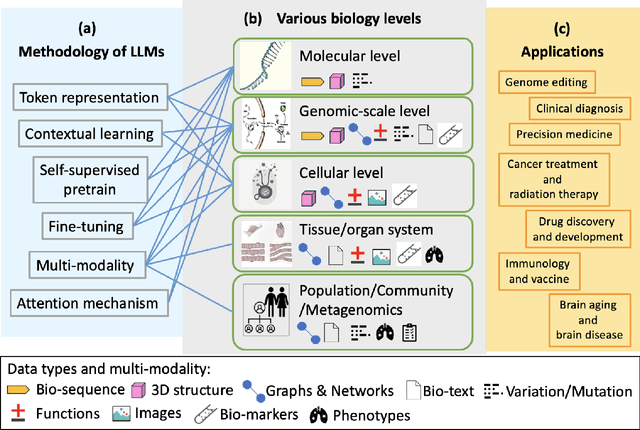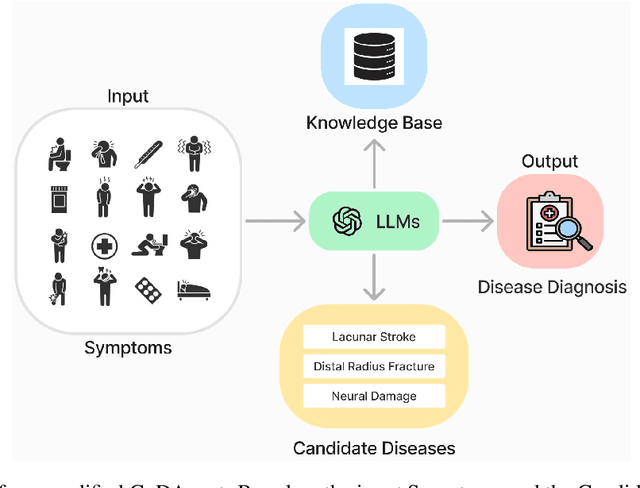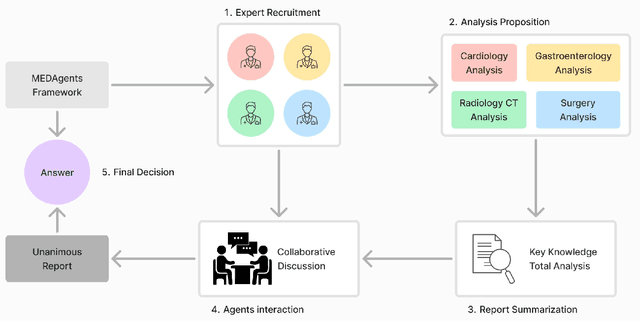Zhengliang Liu
AD-GPT: Large Language Models in Alzheimer's Disease
Apr 03, 2025Abstract:Large language models (LLMs) have emerged as powerful tools for medical information retrieval, yet their accuracy and depth remain limited in specialized domains such as Alzheimer's disease (AD), a growing global health challenge. To address this gap, we introduce AD-GPT, a domain-specific generative pre-trained transformer designed to enhance the retrieval and analysis of AD-related genetic and neurobiological information. AD-GPT integrates diverse biomedical data sources, including potential AD-associated genes, molecular genetic information, and key gene variants linked to brain regions. We develop a stacked LLM architecture combining Llama3 and BERT, optimized for four critical tasks in AD research: (1) genetic information retrieval, (2) gene-brain region relationship assessment, (3) gene-AD relationship analysis, and (4) brain region-AD relationship mapping. Comparative evaluations against state-of-the-art LLMs demonstrate AD-GPT's superior precision and reliability across these tasks, underscoring its potential as a robust and specialized AI tool for advancing AD research and biomarker discovery.
Fine-Tuning Open-Source Large Language Models to Improve Their Performance on Radiation Oncology Tasks: A Feasibility Study to Investigate Their Potential Clinical Applications in Radiation Oncology
Jan 28, 2025



Abstract:Background: The radiation oncology clinical practice involves many steps relying on the dynamic interplay of abundant text data. Large language models have displayed remarkable capabilities in processing complex text information. But their direct applications in specific fields like radiation oncology remain underexplored. Purpose: This study aims to investigate whether fine-tuning LLMs with domain knowledge can improve the performance on Task (1) treatment regimen generation, Task (2) treatment modality selection (photon, proton, electron, or brachytherapy), and Task (3) ICD-10 code prediction in radiation oncology. Methods: Data for 15,724 patient cases were extracted. Cases where patients had a single diagnostic record, and a clearly identifiable primary treatment plan were selected for preprocessing and manual annotation to have 7,903 cases of the patient diagnosis, treatment plan, treatment modality, and ICD-10 code. Each case was used to construct a pair consisting of patient diagnostics details and an answer (treatment regimen, treatment modality, or ICD-10 code respectively) for the supervised fine-tuning of these three tasks. Open source LLaMA2-7B and Mistral-7B models were utilized for the fine-tuning with the Low-Rank Approximations method. Accuracy and ROUGE-1 score were reported for the fine-tuned models and original models. Clinical evaluation was performed on Task (1) by radiation oncologists, while precision, recall, and F-1 score were evaluated for Task (2) and (3). One-sided Wilcoxon signed-rank tests were used to statistically analyze the results. Results: Fine-tuned LLMs outperformed original LLMs across all tasks with p-value <= 0.001. Clinical evaluation demonstrated that over 60% of the fine-tuned LLMs-generated treatment regimens were clinically acceptable. Precision, recall, and F1-score showed improved performance of fine-tuned LLMs.
Large Language Models for Bioinformatics
Jan 10, 2025
Abstract:With the rapid advancements in large language model (LLM) technology and the emergence of bioinformatics-specific language models (BioLMs), there is a growing need for a comprehensive analysis of the current landscape, computational characteristics, and diverse applications. This survey aims to address this need by providing a thorough review of BioLMs, focusing on their evolution, classification, and distinguishing features, alongside a detailed examination of training methodologies, datasets, and evaluation frameworks. We explore the wide-ranging applications of BioLMs in critical areas such as disease diagnosis, drug discovery, and vaccine development, highlighting their impact and transformative potential in bioinformatics. We identify key challenges and limitations inherent in BioLMs, including data privacy and security concerns, interpretability issues, biases in training data and model outputs, and domain adaptation complexities. Finally, we highlight emerging trends and future directions, offering valuable insights to guide researchers and clinicians toward advancing BioLMs for increasingly sophisticated biological and clinical applications.
A recent evaluation on the performance of LLMs on radiation oncology physics using questions of randomly shuffled options
Dec 14, 2024



Abstract:Purpose: We present an updated study evaluating the performance of large language models (LLMs) in answering radiation oncology physics questions, focusing on the latest released models. Methods: A set of 100 multiple-choice radiation oncology physics questions, previously created by us, was used for this study. The answer options of the questions were randomly shuffled to create "new" exam sets. Five LLMs -- OpenAI o1-preview, GPT-4o, LLaMA 3.1 (405B), Gemini 1.5 Pro, and Claude 3.5 Sonnet -- with the versions released before September 30, 2024, were queried using these new exams. To evaluate their deductive reasoning abilities, the correct answer options in the questions were replaced with "None of the above." Then, the explain-first and step-by-step instruction prompt was used to test if it improved their reasoning abilities. The performance of the LLMs was compared to medical physicists in majority-vote scenarios. Results: All models demonstrated expert-level performance on these questions, with o1-preview even surpassing medical physicists in majority-vote scenarios. When substituting the correct answer options with "None of the above," all models exhibited a considerable decline in performance, suggesting room for improvement. The explain-first and step-by-step instruction prompt helped enhance the reasoning abilities of LLaMA 3.1 (405B), Gemini 1.5 Pro, and Claude 3.5 Sonnet models. Conclusion: These latest LLMs demonstrated expert-level performance in answering radiation oncology physics questions, exhibiting great potential for assisting in radiation oncology physics education.
Opportunities and Challenges of Large Language Models for Low-Resource Languages in Humanities Research
Dec 09, 2024Abstract:Low-resource languages serve as invaluable repositories of human history, embodying cultural evolution and intellectual diversity. Despite their significance, these languages face critical challenges, including data scarcity and technological limitations, which hinder their comprehensive study and preservation. Recent advancements in large language models (LLMs) offer transformative opportunities for addressing these challenges, enabling innovative methodologies in linguistic, historical, and cultural research. This study systematically evaluates the applications of LLMs in low-resource language research, encompassing linguistic variation, historical documentation, cultural expressions, and literary analysis. By analyzing technical frameworks, current methodologies, and ethical considerations, this paper identifies key challenges such as data accessibility, model adaptability, and cultural sensitivity. Given the cultural, historical, and linguistic richness inherent in low-resource languages, this work emphasizes interdisciplinary collaboration and the development of customized models as promising avenues for advancing research in this domain. By underscoring the potential of integrating artificial intelligence with the humanities to preserve and study humanity's linguistic and cultural heritage, this study fosters global efforts towards safeguarding intellectual diversity.
QueEn: A Large Language Model for Quechua-English Translation
Dec 06, 2024

Abstract:Recent studies show that large language models (LLMs) are powerful tools for working with natural language, bringing advances in many areas of computational linguistics. However, these models face challenges when applied to low-resource languages due to limited training data and difficulty in understanding cultural nuances. In this paper, we propose QueEn, a novel approach for Quechua-English translation that combines Retrieval-Augmented Generation (RAG) with parameter-efficient fine-tuning techniques. Our method leverages external linguistic resources through RAG and uses Low-Rank Adaptation (LoRA) for efficient model adaptation. Experimental results show that our approach substantially exceeds baseline models, with a BLEU score of 17.6 compared to 1.5 for standard GPT models. The integration of RAG with fine-tuning allows our system to address the challenges of low-resource language translation while maintaining computational efficiency. This work contributes to the broader goal of preserving endangered languages through advanced language technologies.
Foundation Models for Low-Resource Language Education (Vision Paper)
Dec 06, 2024Abstract:Recent studies show that large language models (LLMs) are powerful tools for working with natural language, bringing advances in many areas of computational linguistics. However, these models face challenges when applied to low-resource languages due to limited training data and difficulty in understanding cultural nuances. Research is now focusing on multilingual models to improve LLM performance for these languages. Education in these languages also struggles with a lack of resources and qualified teachers, particularly in underdeveloped regions. Here, LLMs can be transformative, supporting innovative methods like community-driven learning and digital platforms. This paper discusses how LLMs could enhance education for low-resource languages, emphasizing practical applications and benefits.
OracleSage: Towards Unified Visual-Linguistic Understanding of Oracle Bone Scripts through Cross-Modal Knowledge Fusion
Nov 26, 2024



Abstract:Oracle bone script (OBS), as China's earliest mature writing system, present significant challenges in automatic recognition due to their complex pictographic structures and divergence from modern Chinese characters. We introduce OracleSage, a novel cross-modal framework that integrates hierarchical visual understanding with graph-based semantic reasoning. Specifically, we propose (1) a Hierarchical Visual-Semantic Understanding module that enables multi-granularity feature extraction through progressive fine-tuning of LLaVA's visual backbone, (2) a Graph-based Semantic Reasoning Framework that captures relationships between visual components and semantic concepts through dynamic message passing, and (3) OracleSem, a semantically enriched OBS dataset with comprehensive pictographic and semantic annotations. Experimental results demonstrate that OracleSage significantly outperforms state-of-the-art vision-language models. This research establishes a new paradigm for ancient text interpretation while providing valuable technical support for archaeological studies.
Transcending Language Boundaries: Harnessing LLMs for Low-Resource Language Translation
Nov 18, 2024



Abstract:Large Language Models (LLMs) have demonstrated remarkable success across a wide range of tasks and domains. However, their performance in low-resource language translation, particularly when translating into these languages, remains underexplored. This gap poses significant challenges, as linguistic barriers hinder the cultural preservation and development of minority communities. To address this issue, this paper introduces a novel retrieval-based method that enhances translation quality for low-resource languages by focusing on key terms, which involves translating keywords and retrieving corresponding examples from existing data. To evaluate the effectiveness of this method, we conducted experiments translating from English into three low-resource languages: Cherokee, a critically endangered indigenous language of North America; Tibetan, a historically and culturally significant language in Asia; and Manchu, a language with few remaining speakers. Our comparison with the zero-shot performance of GPT-4o and LLaMA 3.1 405B, highlights the significant challenges these models face when translating into low-resource languages. In contrast, our retrieval-based method shows promise in improving both word-level accuracy and overall semantic understanding by leveraging existing resources more effectively.
Towards Next-Generation Medical Agent: How o1 is Reshaping Decision-Making in Medical Scenarios
Nov 16, 2024



Abstract:Artificial Intelligence (AI) has become essential in modern healthcare, with large language models (LLMs) offering promising advances in clinical decision-making. Traditional model-based approaches, including those leveraging in-context demonstrations and those with specialized medical fine-tuning, have demonstrated strong performance in medical language processing but struggle with real-time adaptability, multi-step reasoning, and handling complex medical tasks. Agent-based AI systems address these limitations by incorporating reasoning traces, tool selection based on context, knowledge retrieval, and both short- and long-term memory. These additional features enable the medical AI agent to handle complex medical scenarios where decision-making should be built on real-time interaction with the environment. Therefore, unlike conventional model-based approaches that treat medical queries as isolated questions, medical AI agents approach them as complex tasks and behave more like human doctors. In this paper, we study the choice of the backbone LLM for medical AI agents, which is the foundation for the agent's overall reasoning and action generation. In particular, we consider the emergent o1 model and examine its impact on agents' reasoning, tool-use adaptability, and real-time information retrieval across diverse clinical scenarios, including high-stakes settings such as intensive care units (ICUs). Our findings demonstrate o1's ability to enhance diagnostic accuracy and consistency, paving the way for smarter, more responsive AI tools that support better patient outcomes and decision-making efficacy in clinical practice.
 Add to Chrome
Add to Chrome Add to Firefox
Add to Firefox Add to Edge
Add to Edge